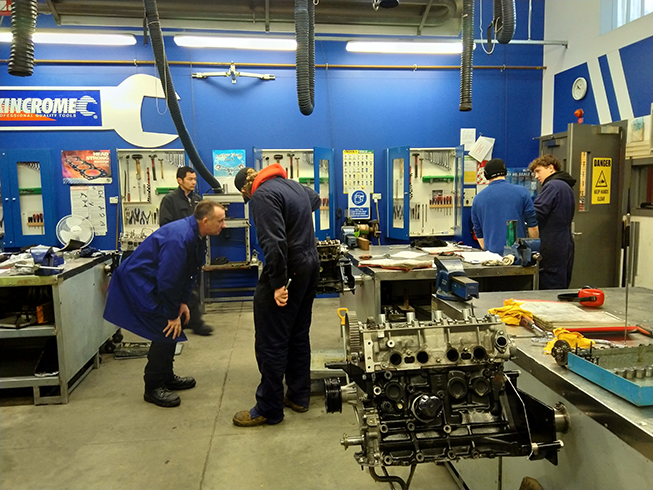Ara Automotive Engineering course in te reo Māori: a first in New Zealand.
Ara Institute of Canterbury will provide all learning materials and assess a trades course in te reo Māori, a first for any non-Māori tertiary institution.
To enable fluent Māori language speakers to learn and be assessed in their native tongue, Ara is currently translating workbooks, marking guides and assessments for its Level 3 Automotive Engineering course, ready for delivery in early 2023.

Sean Flanagan, Senior tutor in Trades, with Automotive Engineering students at Ara’s Woolston campus, Christchurch.
“The initiative began when a student who had been educated in kura kaupapa Māori schools expressed concerns about English-based assessments as part of the automotive training course,” Julie McIlwraith, Ara’s Academic Quality Assurance Manager for Trades says.
“Not only was the learner’s first language an official language, but Ara has a policy that it must consider opportunities for learners to be assessed in Māori if a competent translator and assessor can be found. Ara has several skilled te reo speakers, so when learners like this come with a variety of capabilities, we need to be able to meet them where they’re at.”
The Auto Engineering student would eventually like to start their own auto mechanical repair business which uses te reo Māori as the principal language. This is so people who have come up through kura kaupapa Māori have a culturally attuned place to get their cars repaired.
How to treat the translation of automotive terms like ‘carburettor’ and ‘camshaft’ was an important decision for Ara and part of the kaupapa for the project.
“Many terms don’t currently exist in te reo Māori, so we had to think about whether to use transliterations, such as ‘kāpareta’ for ‘carburettor’, or create our own terms and submit them to Te Taura Whiri i Te Reo - the Māori Language Commission, or to simply use the English terms,” says Reimana Tūtengaehe, the Ara tutor responsible for the translations.
In the end, they decided to use the English terms for any object or activity that does not yet exist in the Māori language. “This is the best choice given the lack of appropriate vocabulary in the language,” noted Tūtengaehe. “It will provide a gradual growth rate for the language and speakers.”
McIlwraith says this is an essential perspective for the whole project. “If we accept that, currently, our learners will end up in workplaces that use the English technical terms, we need to ensure any anticipated barriers to employment are minimised. To do this effectively, allowing the learners to become familiar with terms used in the workplace of today is essential. We’re looking forward to the time when this doesn’t even need to be a consideration,” she says.
The translations are a “massive undertaking” for Tūtengaehe, but he says he looks forward to more courses being translated for students across the country.
“For me, this is a good first step towards providing speakers of Māori with an environment that lets them know their language isn’t foreign to this land and shouldn’t have to be foreign to the disciplines in which they wish to learn. Over time, we can help create a population that might even return to our institutions and further develop these programmes to the point where not only the resources could be provided in te reo, but the entire delivery of the course could happen in te reo too,” he says.